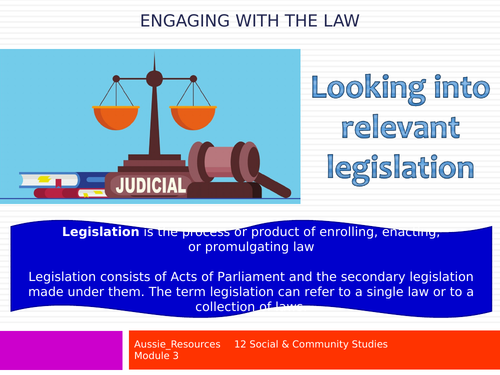
A lesson designed to teach students how to read legislation and explain it in written form. It begins with a warm up quiz to test students retention of information from earlier in the unit (e.g. define key terms, + some multiple choice - why we have laws, what happens when laws are broken, police officers duties etc.) Then it includes an overview of some driving laws which exist to protect us followed by some print and video public service announcements showing the risks of actions like speeding, drink driving etc.) to prompt discussion. Some other laws including smoking, alcohol and violence related laws are also included. Students are then introduced to the Criminal Code Act 1899 (QLD) as this is a document students will engage with during their assessment. They are shown the table of contents and how to use it to find the specific crime they are looking for (screenshots are included in the PPT). Using Wilful Damage as an example we read the definition and the elaboration provided in the sub sections. We then look at the punishment and some information from a law firm about when wilful damage is defendable. Students are shown a table (graphic organiser) which they are to use to write a summary of that law in their own words. We then looked at the specific instances when a higher penalty would be given for this crime, how to report wilful damage and what to do if you have been accused of committing this crime (and the differences in penalty for someone over 18 vs a minor). Students then engaging with the Summary Offences Act of 2005 and have to complete the same graphic organiser for the crime ‘public nuisance.’ This is followed by an explanation of what a penalty unit is and what the current QLD penalty unit is worth (as of 1 July 2020). The lesson concludes with a viewing activity where a lawyer discusses public nuisance in QLD.
To be successful at the end of the lesson, students should know:
• How to navigate the legal documents and how to reference them appropriately (the section and the relevant sub sections.)
• What are penalty units?
• How much are penalty units worth?
• Why repeat offenders have heavier penalties.
Part of a set of resources created for a senior Social & Community studies class in Australia (QCAA syllabus). The other resources are also available in my store – Aussie_Resources. Designed for use in 70 minute lessons. The end of term assessment for this unit was a multimodal presentation.
I pride myself on the quality of the materials I produce, I don’t charge high prices because I don’t agree with paying £10 for a word search. If you need to check before you buy, have a look at some of the free resources in my shop for a sample of the quality and depth.’
Something went wrong, please try again later.
This resource hasn't been reviewed yet
To ensure quality for our reviews, only customers who have purchased this resource can review it
Report this resourceto let us know if it violates our terms and conditions.
Our customer service team will review your report and will be in touch.
